PCR basics
- 格式:pdf
- 大小:330.34 KB
- 文档页数:35
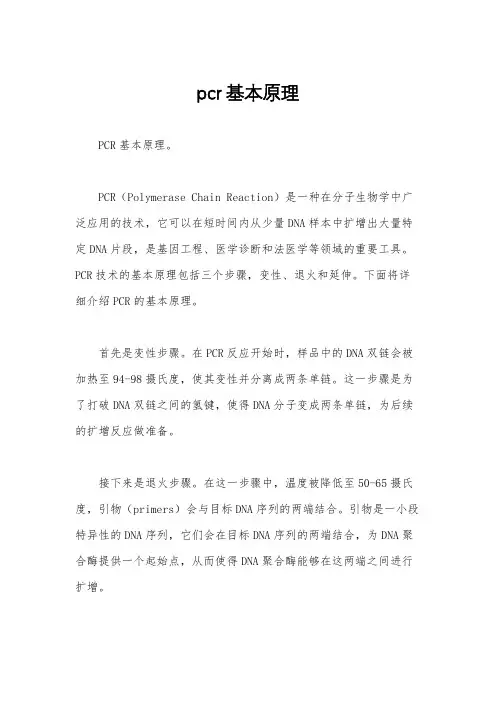
pcr基本原理PCR基本原理。
PCR(Polymerase Chain Reaction)是一种在分子生物学中广泛应用的技术,它可以在短时间内从少量DNA样本中扩增出大量特定DNA片段,是基因工程、医学诊断和法医学等领域的重要工具。
PCR技术的基本原理包括三个步骤,变性、退火和延伸。
下面将详细介绍PCR的基本原理。
首先是变性步骤。
在PCR反应开始时,样品中的DNA双链会被加热至94-98摄氏度,使其变性并分离成两条单链。
这一步骤是为了打破DNA双链之间的氢键,使得DNA分子变成两条单链,为后续的扩增反应做准备。
接下来是退火步骤。
在这一步骤中,温度被降低至50-65摄氏度,引物(primers)会与目标DNA序列的两端结合。
引物是一小段特异性的DNA序列,它们会在目标DNA序列的两端结合,为DNA聚合酶提供一个起始点,从而使得DNA聚合酶能够在这两端之间进行扩增。
最后是延伸步骤。
在这一步骤中,温度被升高至72摄氏度,DNA聚合酶开始在引物的引导下,以模板DNA为模板,合成新的DNA 链。
这样,每一个DNA分子都会在这一轮反应中被扩增成两个分子,经过多轮循环反应,可以得到大量特定DNA片段。
通过这三个步骤的循环,可以在短时间内从少量DNA样本中扩增出大量特定DNA片段。
PCR技术的应用极为广泛,包括基因克隆、DNA测序、疾病诊断、DNA指纹鉴定等领域。
它的高度特异性和敏感性使得PCR技术成为了现代生物学研究中不可或缺的工具。
总之,PCR技术的基本原理是通过反复进行变性、退火和延伸三个步骤,从而实现对DNA片段的快速扩增。
它的应用范围广泛,对于基因工程、医学诊断、法医学等领域都具有重要意义。
PCR技术的发展为生物学研究提供了强大的工具,也为医学诊断和疾病治疗带来了革命性的变革。
PCR技术的不断完善和改进,将会为人类健康和生命科学研究带来更多的机遇和挑战。
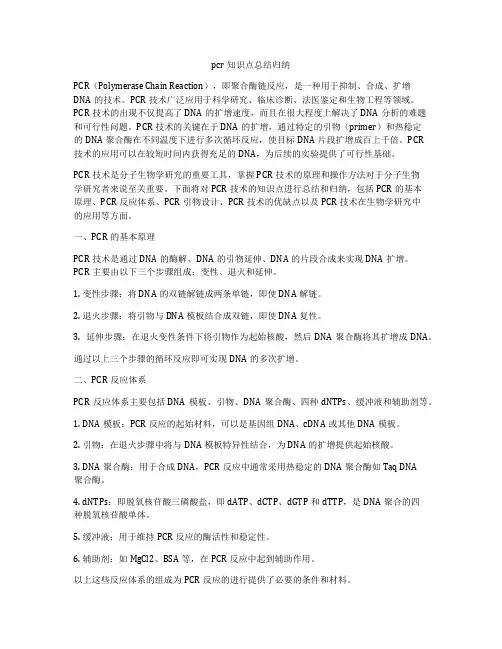
pcr知识点总结归纳PCR(Polymerase Chain Reaction),即聚合酶链反应,是一种用于抑制、合成、扩增DNA的技术。
PCR技术广泛应用于科学研究、临床诊断、法医鉴定和生物工程等领域。
PCR技术的出现不仅提高了DNA的扩增速度,而且在很大程度上解决了DNA分析的难题和可行性问题。
PCR技术的关键在于DNA的扩增,通过特定的引物(primer)和热稳定的DNA聚合酶在不同温度下进行多次循环反应,使目标DNA片段扩增成百上千倍。
PCR技术的应用可以在较短时间内获得充足的DNA,为后续的实验提供了可行性基础。
PCR技术是分子生物学研究的重要工具,掌握PCR技术的原理和操作方法对于分子生物学研究者来说至关重要。
下面将对PCR技术的知识点进行总结和归纳,包括PCR的基本原理、PCR反应体系、PCR引物设计、PCR技术的优缺点以及PCR技术在生物学研究中的应用等方面。
一、PCR的基本原理PCR技术是通过DNA的酶解、DNA的引物延伸、DNA的片段合成来实现DNA扩增。
PCR主要由以下三个步骤组成:变性、退火和延伸。
1. 变性步骤:将DNA的双链解链成两条单链,即使DNA解链。
2. 退火步骤:将引物与DNA模板结合成双链,即使DNA复性。
3. 延伸步骤:在退火变性条件下将引物作为起始核酸,然后DNA聚合酶将其扩增成DNA。
通过以上三个步骤的循环反应即可实现DNA的多次扩增。
二、PCR反应体系PCR反应体系主要包括DNA模板、引物、DNA聚合酶、四种dNTPs、缓冲液和辅助剂等。
1. DNA模板:PCR反应的起始材料,可以是基因组DNA、cDNA或其他DNA模板。
2. 引物:在退火步骤中将与DNA模板特异性结合,为DNA的扩增提供起始核酸。
3. DNA聚合酶:用于合成DNA,PCR反应中通常采用热稳定的DNA聚合酶如Taq DNA聚合酶。
4. dNTPs:即脱氧核苷酸三磷酸盐,即dATP、dCTP、dGTP和dTTP,是DNA聚合的四种脱氧核苷酸单体。

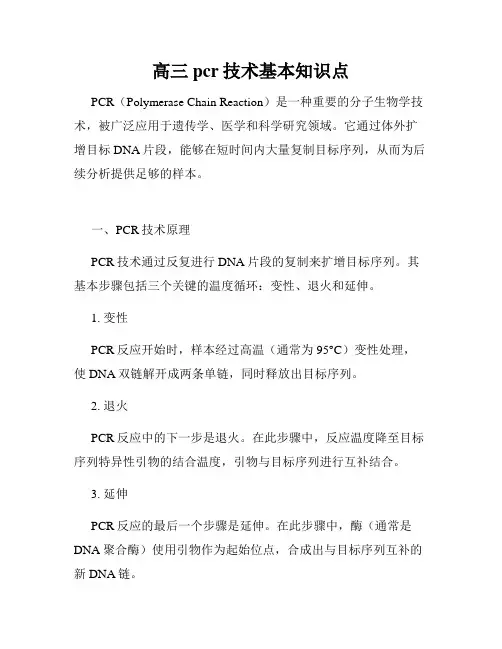
高三pcr技术基本知识点PCR(Polymerase Chain Reaction)是一种重要的分子生物学技术,被广泛应用于遗传学、医学和科学研究领域。
它通过体外扩增目标DNA片段,能够在短时间内大量复制目标序列,从而为后续分析提供足够的样本。
一、PCR技术原理PCR技术通过反复进行DNA片段的复制来扩增目标序列。
其基本步骤包括三个关键的温度循环:变性、退火和延伸。
1. 变性PCR反应开始时,样本经过高温(通常为95°C)变性处理,使DNA双链解开成两条单链,同时释放出目标序列。
2. 退火PCR反应中的下一步是退火。
在此步骤中,反应温度降至目标序列特异性引物的结合温度,引物与目标序列进行互补结合。
3. 延伸PCR反应的最后一个步骤是延伸。
在此步骤中,酶(通常是DNA聚合酶)使用引物作为起始位点,合成出与目标序列互补的新DNA链。
二、PCR反应体系PCR反应所需的要素包括DNA样本、引物(前向引物和逆向引物)、核苷酸三磷酸(dNTPs)、缓冲液和DNA聚合酶。
1. DNA样本PCR反应需要将待扩增的DNA样本加入反应管中,作为起始材料。
2. 引物PCR反应中的引物是两条特异性引物,分别与目标序列的两端互补结合。
通过引物的定向,可以选择扩增目标序列的特定区域。
3. dNTPs反应体系中需要加入四种脱氧核苷酸三磷酸(dATP、dCTP、dGTP和dTTP),以供DNA合成酶在延伸过程中使用。
4. 缓冲液缓冲液可以维持反应体系的pH值,提供合适的离子环境以促进PCR反应。
5. DNA聚合酶DNA聚合酶是PCR反应的关键酶,用于在新合成链中催化核苷酸的连续添加。
三、PCR反应步骤PCR反应由一个或多个PCR循环组成,每个循环包括三个主要步骤:变性、退火和延伸。
整个PCR反应过程通常由30-40个循环组成。
1. 变性PCR反应的第一步是变性。
反应温度升至95°C,将目标序列的DNA双链解开成两条单链DNA。
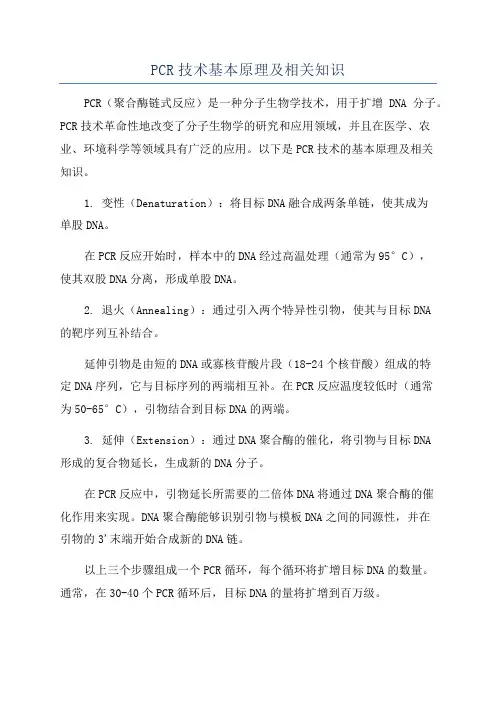
PCR技术基本原理及相关知识PCR(聚合酶链式反应)是一种分子生物学技术,用于扩增DNA分子。
PCR技术革命性地改变了分子生物学的研究和应用领域,并且在医学、农业、环境科学等领域具有广泛的应用。
以下是PCR技术的基本原理及相关知识。
1. 变性(Denaturation):将目标DNA融合成两条单链,使其成为单股DNA。
在PCR反应开始时,样本中的DNA经过高温处理(通常为95°C),使其双股DNA分离,形成单股DNA。
2. 退火(Annealing):通过引入两个特异性引物,使其与目标DNA的靶序列互补结合。
延伸引物是由短的DNA或寡核苷酸片段(18-24个核苷酸)组成的特定DNA序列,它与目标序列的两端相互补。
在PCR反应温度较低时(通常为50-65°C),引物结合到目标DNA的两端。
3. 延伸(Extension):通过DNA聚合酶的催化,将引物与目标DNA形成的复合物延长,生成新的DNA分子。
在PCR反应中,引物延长所需要的二倍体DNA将通过DNA聚合酶的催化作用来实现。
DNA聚合酶能够识别引物与模板DNA之间的同源性,并在引物的3'末端开始合成新的DNA链。
以上三个步骤组成一个PCR循环,每个循环将扩增目标DNA的数量。
通常,在30-40个PCR循环后,目标DNA的量将扩增到百万级。
1.DNA模板:DNA模板是PCR反应的起点,它可以是基因组DNA、cDNA或已知序列的DNA片段。
2.引物设计:引物的选择非常重要,引物应该与目标DNA序列的两端相互补,以确保引物的有效结合和延长。
3. DNA聚合酶:DNA聚合酶是PCR反应的催化剂,通常使用热稳定聚合酶(如Taq聚合酶)。
热稳定聚合酶能够在高温下保持稳定,并且具有较高的DNA聚合活性。
4.PCR缓冲液:PCR反应需要在特定的pH和离子浓度条件下进行,PCR缓冲液可以提供适宜的反应环境。
5.循环条件:PCR反应需要在特定的温度条件下进行循环反应。
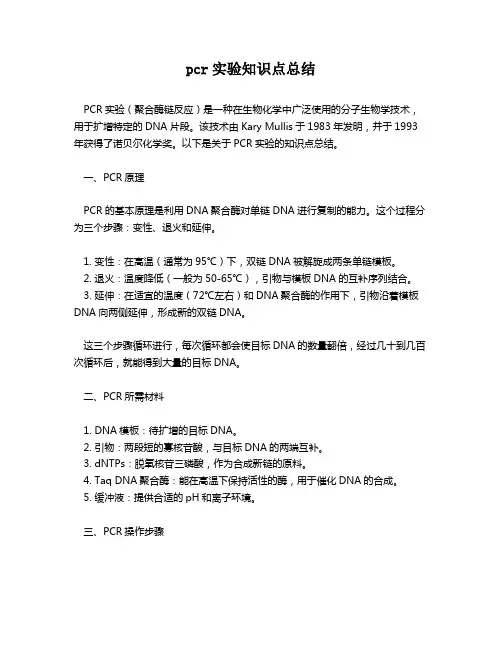
pcr实验知识点总结PCR实验(聚合酶链反应)是一种在生物化学中广泛使用的分子生物学技术,用于扩增特定的DNA片段。
该技术由Kary Mullis于1983年发明,并于1993年获得了诺贝尔化学奖。
以下是关于PCR实验的知识点总结。
一、PCR原理PCR的基本原理是利用DNA聚合酶对单链DNA进行复制的能力。
这个过程分为三个步骤:变性、退火和延伸。
1. 变性:在高温(通常为95℃)下,双链DNA被解旋成两条单链模板。
2. 退火:温度降低(一般为50-65℃),引物与模板DNA的互补序列结合。
3. 延伸:在适宜的温度(72℃左右)和DNA聚合酶的作用下,引物沿着模板DNA向两侧延伸,形成新的双链DNA。
这三个步骤循环进行,每次循环都会使目标DNA的数量翻倍,经过几十到几百次循环后,就能得到大量的目标DNA。
二、PCR所需材料1. DNA模板:待扩增的目标DNA。
2. 引物:两段短的寡核苷酸,与目标DNA的两端互补。
3. dNTPs:脱氧核苷三磷酸,作为合成新链的原料。
4. Taq DNA聚合酶:能在高温下保持活性的酶,用于催化DNA的合成。
5. 缓冲液:提供合适的pH和离子环境。
三、PCR操作步骤1. 设计引物:根据目标DNA的序列设计出两条引物,分别与DNA的正反两条链互补。
2. 配制反应体系:将模板DNA、引物、dNTPs、Taq酶和缓冲液按照一定比例混合。
3. PCR循环:将反应体系放入PCR仪中,设定好变性、退火和延伸的温度和时间,开始循环反应。
4. 产物检测:可以通过凝胶电泳等方法检测PCR产物的大小和数量。
四、PCR的应用1. 分子诊断:如病原体检测、基因突变检测等。
2. 基因克隆:将目的基因扩增后,可以方便地进行后续的克隆和表达。
3. 序列分析:通过扩增特定的基因区域,可以进行基因测序和SNP分析等。
4. 生物考古学:可以从古代样本中提取DNA并进行扩增,研究古生物的遗传信息。
五、PCR实验注意事项1. 引物设计:引物应具有良好的特异性和稳定性,避免产生非特异性扩增和二级结构。
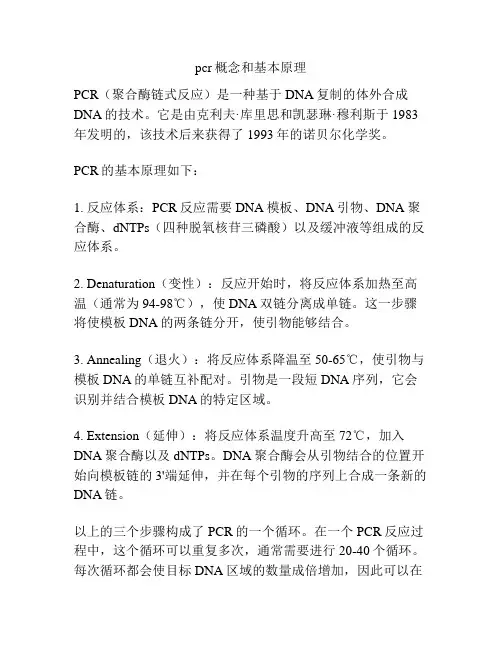
pcr概念和基本原理
PCR(聚合酶链式反应)是一种基于DNA复制的体外合成DNA的技术。
它是由克利夫·库里思和凯瑟琳·穆利斯于1983年发明的,该技术后来获得了1993年的诺贝尔化学奖。
PCR的基本原理如下:
1. 反应体系:PCR反应需要DNA模板、DNA引物、DNA聚合酶、dNTPs(四种脱氧核苷三磷酸)以及缓冲液等组成的反应体系。
2. Denaturation(变性):反应开始时,将反应体系加热至高温(通常为94-98℃),使DNA双链分离成单链。
这一步骤将使模板DNA的两条链分开,使引物能够结合。
3. Annealing(退火):将反应体系降温至50-65℃,使引物与模板DNA的单链互补配对。
引物是一段短DNA序列,它会识别并结合模板DNA的特定区域。
4. Extension(延伸):将反应体系温度升高至72℃,加入DNA聚合酶以及dNTPs。
DNA聚合酶会从引物结合的位置开始向模板链的3'端延伸,并在每个引物的序列上合成一条新的DNA链。
以上的三个步骤构成了PCR的一个循环。
在一个PCR反应过程中,这个循环可以重复多次,通常需要进行20-40个循环。
每次循环都会使目标DNA区域的数量成倍增加,因此可以在
几小时内从极少量的DNA样本中合成大量的DNA。
PCR可以用于多种应用,包括基因突变的检测、DNA序列的测定、基因克隆、疾病诊断等。
它在分子生物学研究、医学诊断和法庭鉴定等领域起着重要作用。
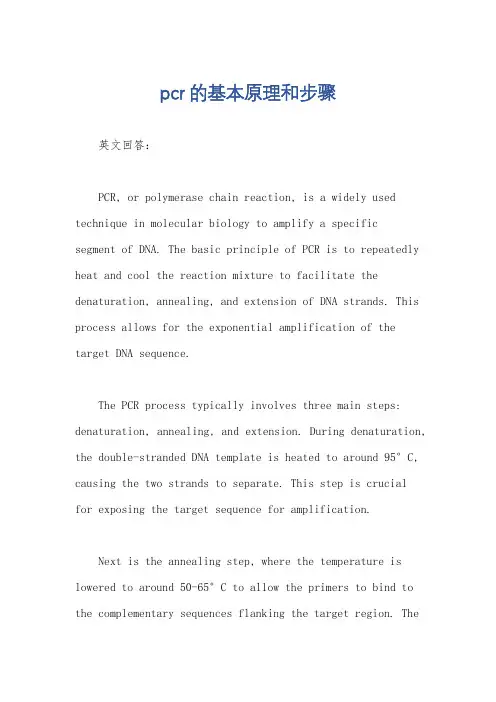
pcr的基本原理和步骤英文回答:PCR, or polymerase chain reaction, is a widely used technique in molecular biology to amplify a specific segment of DNA. The basic principle of PCR is to repeatedly heat and cool the reaction mixture to facilitate the denaturation, annealing, and extension of DNA strands. This process allows for the exponential amplification of the target DNA sequence.The PCR process typically involves three main steps: denaturation, annealing, and extension. During denaturation, the double-stranded DNA template i s heated to around 95°C, causing the two strands to separate. This step is crucialfor exposing the target sequence for amplification.Next is the annealing step, where the temperature is lowered to around 50-65°C to allow the primers to bind to the complementary sequences flanking the target region. Theprimers are short DNA sequences that serve as starting points for DNA synthesis.Finally, in the extension step, the temperature is raised to around 72°C, which is the optimal temperaturefor the DNA polymerase to synthesize new DNA strands by extending from the primers. This process results in the duplication of the target DNA sequence.Overall, PCR is a powerful tool that enables researchers to generate millions of copies of a specific DNA sequence in a relatively short amount of time. It has a wide range of applications, from genetic testing to forensics to studying gene expression.中文回答:PCR,即聚合酶链反应,是分子生物学中广泛使用的技术,用于放大特定的DNA片段。
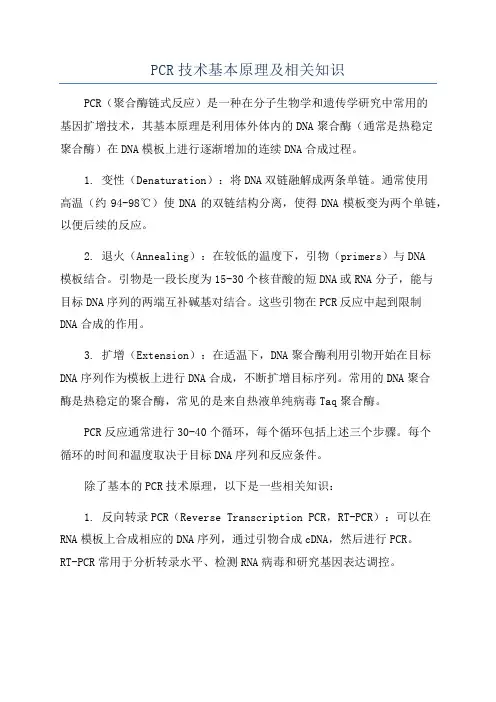
PCR技术基本原理及相关知识PCR(聚合酶链式反应)是一种在分子生物学和遗传学研究中常用的基因扩增技术,其基本原理是利用体外体内的DNA聚合酶(通常是热稳定聚合酶)在DNA模板上进行逐渐增加的连续DNA合成过程。
1. 变性(Denaturation):将DNA双链融解成两条单链。
通常使用高温(约94-98℃)使DNA的双链结构分离,使得DNA模板变为两个单链,以便后续的反应。
2. 退火(Annealing):在较低的温度下,引物(primers)与DNA模板结合。
引物是一段长度为15-30个核苷酸的短DNA或RNA分子,能与目标DNA序列的两端互补碱基对结合。
这些引物在PCR反应中起到限制DNA合成的作用。
3. 扩增(Extension):在适温下,DNA聚合酶利用引物开始在目标DNA序列作为模板上进行DNA合成,不断扩增目标序列。
常用的DNA聚合酶是热稳定的聚合酶,常见的是来自热液单纯病毒Taq聚合酶。
PCR反应通常进行30-40个循环,每个循环包括上述三个步骤。
每个循环的时间和温度取决于目标DNA序列和反应条件。
除了基本的PCR技术原理,以下是一些相关知识:1. 反向转录PCR(Reverse Transcription PCR,RT-PCR):可以在RNA模板上合成相应的DNA序列,通过引物合成cDNA,然后进行PCR。
RT-PCR常用于分析转录水平、检测RNA病毒和研究基因表达调控。
3. 嵌段PCR(Nested PCR):在传统的PCR反应后,再次进行PCR,使用内部引物扩增上一次PCR反应获得的产物。
嵌段PCR提高了灵敏度和特异性。
4. 随机引物PCR(Random Primed PCR):使用随机引物作为引物,能扩增DNA模板上的所有可能的序列,常用于建立基因文库和DNA指纹。
PCR技术在许多领域应用广泛,如医学诊断、遗传学研究、基因工程等。
其快速、高效、灵敏和特异性的特点使其成为现代生物学研究中不可或缺的工具。
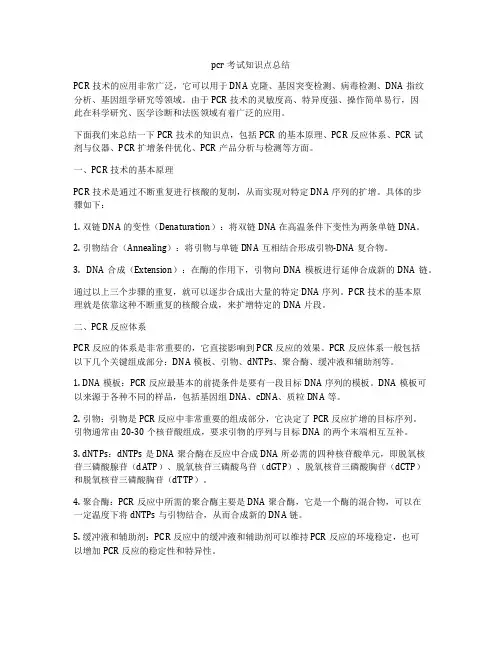
pcr考试知识点总结PCR技术的应用非常广泛,它可以用于DNA克隆、基因突变检测、病毒检测、DNA指纹分析、基因组学研究等领域。
由于PCR技术的灵敏度高、特异度强、操作简单易行,因此在科学研究、医学诊断和法医领域有着广泛的应用。
下面我们来总结一下PCR技术的知识点,包括PCR的基本原理、PCR反应体系、PCR试剂与仪器、PCR扩增条件优化、PCR产品分析与检测等方面。
一、PCR技术的基本原理PCR技术是通过不断重复进行核酸的复制,从而实现对特定DNA序列的扩增。
具体的步骤如下:1. 双链DNA的变性(Denaturation):将双链DNA在高温条件下变性为两条单链DNA。
2. 引物结合(Annealing):将引物与单链DNA互相结合形成引物-DNA复合物。
3. DNA合成(Extension):在酶的作用下,引物向DNA模板进行延伸合成新的DNA链。
通过以上三个步骤的重复,就可以逐步合成出大量的特定DNA序列。
PCR技术的基本原理就是依靠这种不断重复的核酸合成,来扩增特定的DNA片段。
二、PCR反应体系PCR反应的体系是非常重要的,它直接影响到PCR反应的效果。
PCR反应体系一般包括以下几个关键组成部分:DNA模板、引物、dNTPs、聚合酶、缓冲液和辅助剂等。
1. DNA模板:PCR反应最基本的前提条件是要有一段目标DNA序列的模板。
DNA模板可以来源于各种不同的样品,包括基因组DNA、cDNA、质粒DNA等。
2. 引物:引物是PCR反应中非常重要的组成部分,它决定了PCR反应扩增的目标序列。
引物通常由20-30个核苷酸组成,要求引物的序列与目标DNA的两个末端相互互补。
3. dNTPs:dNTPs是DNA聚合酶在反应中合成DNA所必需的四种核苷酸单元,即脱氧核苷三磷酸腺苷(dATP)、脱氧核苷三磷酸鸟苷(dGTP)、脱氧核苷三磷酸胸苷(dCTP)和脱氧核苷三磷酸胸苷(dTTP)。
4. 聚合酶:PCR反应中所需的聚合酶主要是DNA聚合酶,它是一个酶的混合物,可以在一定温度下将dNTPs与引物结合,从而合成新的DNA链。
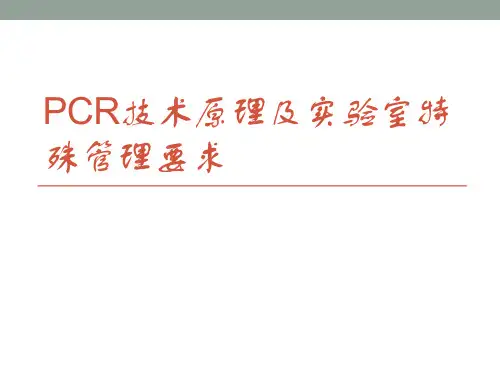
PCR技术丨基本原理、各步骤目的、反应体系一PCR技术基本原理PCR是一种选择性体外快速扩增DNA片段的方法。
在体外以类似于细胞内DNA的半保留复制过程,以拟扩增的模板DNA分子,与模板DNA互补的寡核苷酸引物、DNA聚合酶、4种dNTP及适合的缓冲体系组成的反应体系,经过重复地变性一退火一延伸三步,扩增新的目的DNA链,这个过程通过控制反应体系的温度来实现。
PCR包含下列三步反应:1、变性(denaturation)将反应体系混合物经加热至94℃左右,维持较短的时间,使双链DNA变成单链DNA,便于下一步引物的结合。
2、退火(annealing)将反应体系温度下降到特定温度(一般是引物的Tm值以下),引物与DNA模板以碱基互补的方式结合,形成模板-引物杂交双链。
退火温度是保证引物与DNA模板互补结合的关键。
由于引物结构简单,加之引物量远远大于模板DNA的数量,所以DNA模板单链之间的互补结合很少。
3、延伸(elongation)将反应体系的温度上升到72℃左右并维持一段时间,在Taq DNA 聚合酶的作用下,以引物为起始点,以4种单核苷酸(dNTP)为底物,从5'→3'方向延伸反应,合成新的DNA双链。
以上三步反应为一个循环,重复进行变性、退火、延伸这三步反应,如此反复循环可以使DNA以指数形式进行扩增。
上述过程1.5小时左右完成,从而使所需的目的DNA片段扩增放大百万倍。
二PCR各步骤目的1、预变性破坏DNA中可能存在较难破坏的二级结构。
使DNA充分变性,减少DNA复杂结构对扩增的影响,以利于引物更好地和模板结合,特别是对于基因组来源的DNA模板,最好不要省去这个步骤。
此外,在一些使用热启动Taq酶的反应中,还可激活Taq酶,从而使PCR反应得以顺利进行。
2、变性一退火一延伸循环(1)模板DNA的变性模板DNA经加热至93℃左右一定时间后,使模板DNA双链或经PCR扩增形成的双徒DNA解离,使之成为单链,以便它与引物结合,为下轮反应做准备。
pcr技术的基本原理和过程详解下载温馨提示:该文档是我店铺精心编制而成,希望大家下载以后,能够帮助大家解决实际的问题。
文档下载后可定制随意修改,请根据实际需要进行相应的调整和使用,谢谢!并且,本店铺为大家提供各种各样类型的实用资料,如教育随笔、日记赏析、句子摘抄、古诗大全、经典美文、话题作文、工作总结、词语解析、文案摘录、其他资料等等,如想了解不同资料格式和写法,敬请关注!Download tips: This document is carefully compiled by theeditor.I hope that after you download them,they can help yousolve practical problems. The document can be customized andmodified after downloading,please adjust and use it according toactual needs, thank you!In addition, our shop provides you with various types ofpractical materials,such as educational essays, diaryappreciation,sentence excerpts,ancient poems,classic articles,topic composition,work summary,word parsing,copy excerpts,other materials and so on,want to know different data formats andwriting methods,please pay attention!一、PCR技术的基本原理1. PCR技术概述1.1.1 PCR全称为聚合酶链式反应,是一种在体外复制特定DNA片段的分子生物学技术。
pcr技术的知识点PCR 技术的知识点PCR 技术,全称聚合酶链式反应(Polymerase Chain Reaction),是一种在分子生物学领域中极为重要的技术手段。
它就像是一把神奇的钥匙,能够让我们在微观世界里打开探索生命奥秘的大门。
PCR 技术的基本原理其实并不复杂。
想象一下,我们要复制一份非常珍贵的文件,但这份文件只有一个小小的片段。
首先,我们需要知道这个片段的开头和结尾在哪里,这就相当于 PCR 中的引物。
引物是一小段与我们想要复制的 DNA 片段两端互补的核苷酸序列。
然后,我们有一个特殊的“复印机”,那就是 DNA 聚合酶。
它能够根据已有的模板,一个碱基一个碱基地合成新的 DNA 链。
在 PCR 反应的过程中,一般会经历三个主要的步骤:变性、退火和延伸。
变性阶段,就像是把一本整齐的书撕得粉碎。
高温使得 DNA 双螺旋结构的两条链解开,变成两条单独的链。
这就为后续的复制做好了准备。
退火阶段,就像给这些零散的纸片找到了它们的伙伴。
降低温度,让引物能够与解开的 DNA 单链结合,准确地找到我们想要复制的那一段的起始和结束位置。
延伸阶段,就是真正的复制过程啦。
DNA 聚合酶沿着引物开始工作,从引物的 3'端开始,一个一个地添加碱基,合成新的 DNA 链。
经过一轮这样的过程,我们想要复制的 DNA 片段数量就翻倍了。
然后不断重复这个过程,经过多次循环,就能够在短时间内得到大量的特定 DNA 片段。
PCR 技术的优点那可是相当多。
首先,它的灵敏度极高。
哪怕初始样本中只有极少量的目标 DNA,也能够被检测和扩增出来。
这对于检测病原体、基因突变等微量存在的物质非常有用。
其次,特异性强。
只要引物设计得准确,就能够精确地扩增我们想要的那段 DNA,而不会扩增其他无关的区域。
再者,它操作相对简单,在实验室里容易实现。
PCR 技术在很多领域都发挥着巨大的作用。
在医学领域,它可以用于疾病的诊断。
比如,检测病毒感染,像新冠病毒,通过 PCR 技术能够快速准确地确定是否感染。
Using molecular marker technology in studies on plant genetic diversityDNA-based technologiesPCR-based technologiesPCR basicsCopyright: IPGRI and Cornell University, 2003PCR basics 1Contents!The polymerase chain reaction!PCR procedures:•Steps•Cycle 1•Cycle 2•Cycle 3•Conditions for cycling•Conditions for the reaction mixture•Components•Equipment!PCR technology in picturesCopyright: IPGRI and Cornell University, 2003PCR basics 2The polymerase chain reactionPCR is a rapid, inexpensive and simple way ofcopying specific DNA fragments from minutequantities of source DNA material•It does not necessarily require the use ofradioisotopes or toxic chemicals•It involves preparing the sample DNA anda master mix with primers, followed bydetecting reaction productsCopyright: IPGRI and Cornell University, 2003PCR basics 3The polymerase chain reaction (PCR; Erlich, 1989) is a powerful technique that has rapidly become one of the most widely used techniques in molecular biology because it is quick, inexpensive and simple. The technique amplifies specific DNA fragments from minute quantities of source DNA material, even when that source DNA is of relatively poor quality.ReferenceErlich, H.A. 1989. PCR technology: principles and applications for DNA amplifications.Stockton Press, NY.Copyright: IPGRI and Cornell University, 2003PCR basics 4The DNA polymerase, known as 'Taq polymerase', is named after the hot-spring bacterium Thermus aquaticus from which it was originally isolated. The enzyme can withstand the high temperatures needed for DNA-strand separation, and can be left in the reaction tube.The cycle of heating and cooling is repeated over and over, stimulating the primers to bind to the original sequences and to newly synthesised sequences. The enzyme will again extend primer sequences. This cycling of temperatures results in copying and thencopying of copies, and so on, leading to an exponential increase in the number of copies of specific sequences. Because the amount of DNA placed in the tube at the beginning is very small, almost all the DNA at the end of the reaction cycles is copied sequences.The reaction products are separated by gel electrophoresis. Depending on the quantity produced and the size of the amplified fragment, the reaction products can be visualised directly by staining with ethidium bromide or a silver-staining protocol, or by means of radioisotopes and autoradiography.!Denaturation : DNA fragments are heated at hightemperatures, which reduce the DNA double helix tosingle strands. These strands become accessible toprimers!Annealing : The reaction mixture is cooled down.Primers anneal to the complementary regions in theDNA template strands, and double strands are formedagain between primers and complementary sequences!Extension: The DNA polymerase synthesises acomplementary strand. The enzyme reads the opposingstrand sequence and extends the primers by addingnucleotides in the order in which they can pair. Thewhole process is repeated over and overThe PCR steps are all carried out, one after the other, in bouts of cycling. Cycle 1 is as follows:•During denaturation (about 1 min at 95°C), the DNA strands separate to formsingle strands.•During annealing (about 1 min at temperatures ranging between 45°C and 60°C),one primer binds to one DNA strand and another binds to the complementarystrand. The annealing sites of the primers are chosen so that they will prime DNA synthesis in the region of interest during extension.•During extension (about 1 min at 72°C), the DNA synthesis proceeds through the target region and for variable distances into the flanking region, giving rise to 'long fragments' of variable lengths Double-stranded template DNA5´3´3´5´DenaturingAnnealingExtensionPrimer 1Primer 25´3´5´3´3´5´3´5´3´5´5´3´Primer recognition sitePrimer recognition siteAdapted from Griffiths et al. 1996When the second cycle starts, there are effectively two types of template: (1) the original DNA strands; and (2) the newly synthesised DNA strands, consisting of the target region and variable lengths of the flanking region at the 3' end. When the latter template is used in this cycle, only the target region is replicated.Adapted from Griffiths et al. 1996DenaturingAnnealing Extension 5´Newly synthesised DNA3´5´3´3´5´3´5´}T emplate DNA in the 2nd cycle Original DNA 5´3´5´3´3´5´3´5´5´3´3´5´5´3´3´5´5´3´5´3´3´5´3´5´5´3´5´3´5´3´3´5´In the third cycle, the newly synthesised target region DNA (i.e. without flanking regions)acts as template. The original DNA molecule is still present, and will be until the end of the reaction. However, after a few cycles, the newly synthesised DNA fragment quickly establishes itself as the predominant template.Cycles are typically repeated 25 to 45 times. Standardisation of the thermocycler's running conditions is essential for the reproducibility of results.}Template DNA in the 3rd cycle And so onDenaturing AnnealingExtensionAdapted from Griffiths et al. 1996PCR procedures: conditions for cycling!Complete denaturation of the DNA template!Optimal annealing temperature!Optimal extension temperature!Number of PCR cycles!Final extension stepCopyright: IPGRI and Cornell University, 2003PCR basics 8In the initial denaturation step, complete denaturation of the DNA template at the start of the PCR reaction is essential. Incomplete denaturation of DNA will result in the inefficient use of the template in the first amplification cycle and, consequently, poor yield of PCR product.The annealing temperature may be estimated as 5°C lower than the melting temperature of the primer-template DNA duplex. If non-specific PCR products are obtained in addition to the expected product, the annealing temperature can be optimised by increasing it stepwise by 1-2°C.Usually, the extension step is performed at 72°C and a 1-min extension is sufficient to synthesise PCR fragments as long as 2 kb (kb = kilobase = 1000 bp). When larger DNA fragments are amplified, time is usually extended by 1 min per 1000 bp.The number of PCR cycles will basically depend on the expected yield of the PCR product. After the last cycle, samples are usually incubated at 72°C for 5 min to fill in the protruding ends of newly synthesised PCR products.Copyright: IPGRI and Cornell University, 2003PCR basics 9PCR procedures: conditions for the reaction mixtureContamination of the DNA must be prevented by:!Separating the areas for DNA extraction andPCR!Using sole-purpose laboratory equipment!Autoclaving and aliquoting!Adding a control reactionSome useful tips:•DNA extraction and PCR reaction mixing and processing should be performed in separate areas.•Use of sole-purpose vessels and positive displacement pipettes or tips for DNA sample and reaction mixture preparation is strongly recommended.•All solutions, except dNTPs, primers and Taq DNA polymerase, should be autoclaved. Where possible, solutions should be aliquoted in small quantities and stored in designated PCR areas.•A good practice, to confirm absence of contamination, is to add a control reaction without template DNA.Copyright: IPGRI and Cornell University, 2003PCR basics 10PCR procedures: componentsComponents:•Sterile deionised water•10X PCR buffer•dNTP mix•Primer•T aq DNA polymerase•MgCl 2•T emplate DNA Many PCR machines are now available in 48-, 96- or 384-well formats. This, combined with the use of multichannel pipettors, can greatly increase the number of reactions that can be done simultaneously. If several reactions need to be simultaneously prepared, a master mix should be used as follows: water, buffer, dNTPs, primers, MgCl 2 and Taq DNA polymerase in a single tube. This will then be aliquoted into individual tubes.Considerations:Template DNA. Nearly any standard method is suitable for template DNA purification.An adequate amount of template DNA is between 0.1 and 1 µg for genomic DNA for a total reaction mixture of 100 µl. Larger template DNA amounts usually increase the yield of non-specific PCR products.Primers. (1) PCR primers should be 10-24 nucleotides in length. (2) The GC content should be 40%-60%. (3) The primer should not be self-complementary or complementary to any other primer in the reaction mixture, to prevent primer-dimer and hairpin formation.(4) Melting temperatures of primer pairs should not differ by more than 5°C, so that the GC content and length must be chosen accordingly. (5) The melting and annealing temperatures of a primer are estimated as follows: if the primer is shorter than 25nucleotides, the approximate melting temperature is calculated with the formula: Tm = 4(G + C) + 2 (A + T). (6) The annealing temperature should be about 5°C lower than the melting temperature.MgCl 2 concentration. Because Mg 2+ ions form complexes with dNTPs, primers and DNA templates, the optimal concentration of MgCl 2 has to be selected for each experiment. Too few Mg 2+ ions result in a low yield of PCR product, and too many will increase the yield of non-specific products. The recommended range of MgCl 2concentration is 1 to 3 mM, under the standard reaction conditions specified.Taq DNA polymerase. Higher Taq DNA polymerase concentrations than needed may cause synthesis of non-specific products.dNTPs. The concentration of each dNTP (dA TP , dCTP , dGTP , dTTP) in the reaction mixture is usually 200 µM. These concentrations must be checked as being equal,because inaccuracies will increase the degree of misincorporation.Considerations:•T emplate DNA •Primers •MgCl 2 concentration •T aq polymerase •dNTPsPCR procedures: equipment!Micropipettes!Thermocycler!Electrophoresis units!Power supply units!Photographic equipmentCopyright: IPGRI and Cornell University, 2003PCR basics 11PCR technology in picturesThe following photographs demonstrate how PCR technology is carried outCopyright: IPGRI and Cornell University, 2003PCR basics 12Copyright: IPGRI and Cornell University, 2003PCR basics 13The PCR mixture is prepared on ice. Safety clothing is not required, but may benefit the reaction unless good sterile techniques are practised.Copyright: IPGRI and Cornell University, 2003PCR basics 14 The PCR reactions are loaded into the thermocycler.Copyright: IPGRI and Cornell University, 2003PCR basics 15 The thermocycler is locked shut and programmed.Copyright: IPGRI and Cornell University, 2003PCR basics 16 Different types of thermocyclers exist: the black one is a tetrad, in which 4 sets of 96 samples can be run simultaneously. The four smaller white ones each have a 96-well capacity.Copyright: IPGRI and Cornell University, 2003PCR basics 17 Depending on the size of the PCR bands produced and the discrimination needed, band visualisation can be accomplished through either a regular, horizontal, agarose gel or a vertical acrylamide sequencing gel (see next slide). Here, the products are being run on an agarose gel.Copyright: IPGRI and Cornell University, 2003PCR basics 18The acrylamide gel may be run in either an independent unit or an automatic sequencer. The preparation of the sequencing gel, although somewhat complicated to set up, is similar for both cases. Here, the glass is being cleaned and wiped before preparing the gel for an automatic sequencer.Copyright: IPGRI and Cornell University, 2003PCR basics 19 Glass units are being inserted into the frame, which will be fitted into the sequencer.Copyright: IPGRI and Cornell University, 2003PCR basics 20The glass units are clamped into place, and the entire unit readied for gel to be poured in.Copyright: IPGRI and Cornell University, 2003PCR basics 21 Liquid acrylamide gel is poured into the mould. Because acrylamide is a carcinogen, safety clothing must be worn.Copyright: IPGRI and Cornell University, 2003PCR basics 22 Clamps grip the bottom ends of the glass units to prevent the gel leaking.Copyright: IPGRI and Cornell University, 2003PCR basics 23A comb is inserted into the top of the gel to create the wells into which the samples will be loaded.Copyright: IPGRI and Cornell University, 2003PCR basics 24 Once the gel is set, the unit is placed into the sequencing machine.Copyright: IPGRI and Cornell University, 2003PCR basics 25 Samples are taken up with a multi-pipettor …Copyright: IPGRI and Cornell University, 2003PCR basics 26…and loaded into the wells of the gel.Copyright: IPGRI and Cornell University, 2003PCR basics 27This is a close-up from the previous photograph. Note the extremely small size of the wells and the pipettor, making it possible to load large numbers of samples into each gel.Copyright: IPGRI and Cornell University, 2003PCR basics 28A heating plate is placed against the gel to ensure a constant performing temperature.Copyright: IPGRI and Cornell University, 2003PCR basics 29 Gel buffer is loaded into the top tank…Copyright: IPGRI and Cornell University, 2003PCR basics 30…and into the bottom tank.Copyright: IPGRI and Cornell University, 2003PCR basics 31 A final look, then the door is shut and the program begun.In summary!PCR is a simple technique to obtain manycopies of specific DNA fragments!Three steps are involved in PCR: denaturation, annealing and extension!T o ensure success, care should be taken both in preparing the reaction mixture and setting up the cycling conditionsCopyright: IPGRI and Cornell University, 2003PCR basics 32By now you should know!What the basis of PCR is!Those items that can affect the performance of the PCR, step by step, and what their effects on PCR results would beCopyright: IPGRI and Cornell University, 2003PCR basics 33Basic referencesErlich, H.A. 1989. PCR technology: principles and applications for DNA amplifications.Stockton Press, NY.Erlich, H.A. and N. Arnheim. 1992. Genetic analysis using the polymerase chain reaction. Ann. Rev. Genet. 26:479-506.Griffiths, A.J.F., J.H. Miller, D.T. Suzuki, R.C. Lewontin and W.M. Gelbart. 1996. An introduction to genetic analysis (6th edn.). W.H. Freeman and Co., NY.Newton, C.R. and A. Graham. 1994. PCR, part 1: Basic principles and methods.EngBios Scientific Publishers, Oxford.Saiki, R.K., D.H. Gelfand, S. Stoffel, S.J. Scharf, R. Higuchi, G.T. Horn, K.B. Mullis andH.A. Erlich. 1988. Primer-directed enzymatic amplification of DNA with athermostable DNA polymerase. Science 239:487-491.NextDNA-based technologiesPCR-based technologiesPCR with arbitrary primers!DNA-based technologies•PCR-based technologies•Amplified fragment length polymorphisms (AFLPs)•Sequences-tagged sites (STS)•Latest strategies!Complementary technologies!Final considerations!GlossaryCopyright: IPGRI and Cornell University, 2003PCR basics 35。